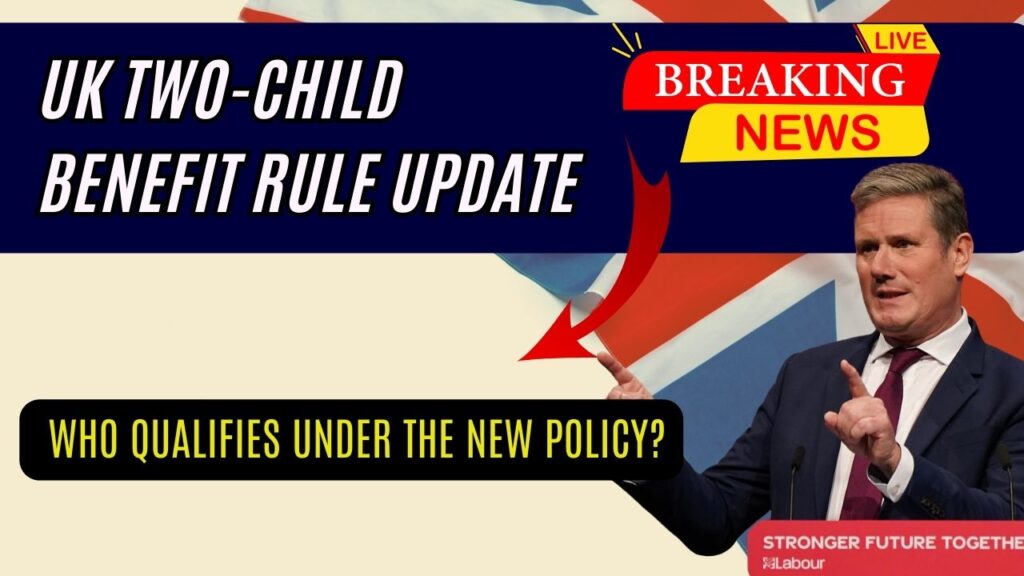UK Two-Child Benefit Rule Update – If you’re a parent in the UK claiming Universal Credit or Child Tax Credit, you’ve probably heard of the two-child benefit rule. But with growing political debate and talk of reforms, it’s more important than ever to understand exactly who qualifies, what exceptions apply, and how you can still receive support if you have more than two children.

In this guide, we’ll explain the UK two-child limit, the latest proposals for change, and offer practical advice to help you navigate this rule. Whether you’re a parent, professional, or policy-watcher, this is everything you need to know in 2025.
UK Two-Child Benefit Rule Update
| Topic | Details |
|---|---|
| Policy in Focus | UK Two-Child Benefit Rule under Universal Credit & Child Tax Credit |
| Start Date | Applies to children born after 6 April 2017 |
| Who Qualifies? | First two children in most households |
| Exceptions Include | Multiple births, adoption from care, non-consensual conception, non-parental care |
| Families Affected | Over 400,000 families, impacting 1.5 million children |
| Proposed Changes | Exemptions for children under 5 or with disabilities (not yet implemented) |
| Official Resource | Gov.uk – Two-Child Rule Guidance |
The UK Two-Child Benefit Rule remains a defining feature of the UK’s welfare system in 2025, impacting hundreds of thousands of families. While there are valid exceptions and growing calls for reform, the rule is still in effect — and many families remain unaware of what support they can still access.
Understanding the rule, checking your eligibility, and using free support services could make a real difference to your family’s finances.
What Is the Two-Child Limit and Who Does It Affect?
The two-child benefit rule restricts additional child-related payments under Universal Credit and Child Tax Credit to a family’s first two children — if they were born after April 6, 2017.
That means:
If you have three or more children born after that date, you will only receive benefit support for the first two — unless you qualify for an exception.
The rule was introduced to reduce welfare costs and “promote fairness” between working families and those receiving state support. However, it has faced criticism for pushing more families into child poverty.
Who Is Most Affected?
- Working parents on low income
- Single-parent households
- Families with three or more children born after April 2017
- Ethnic minority households, who statistically tend to have larger families
According to the Child Poverty Action Group (CPAG), this policy is the biggest driver of rising child poverty in the UK.
Exceptions – Who Still Qualifies for More Than Two Children?
If you meet specific criteria, you can claim for more than two children. Here are the main exceptions:
Multiple Births
If your additional children are twins or triplets, you can still claim for them beyond the first child of the multiple birth.
Example: You have two children and then give birth to twins — you can receive payments for all four children.
Adopted Children
If you adopt a child from local authority care, that child is exempt from the rule. Private adoptions or stepchildren do not qualify.
Non-Parental Care
If you’re looking after a child that would otherwise be in care (e.g. kinship care), you can claim for them regardless of how many children you have.
Non-Consensual Conception
If a child was conceived as a result of rape or coercive control, that child may be excluded from the limit — verified through a third-party professional.
For more details, visit the official Gov.uk guidance.
Real-Life Example
Sarah, a single mother from Manchester, has four children — two born before 2017 and two born after. Her youngest was part of a twin birth. Under the two-child rule, she only received support for her first two children — but after applying under the multiple births exception, she now also receives support for one of the twins.
What Changes Are Being Proposed in 2025?
The Labour Party, along with major charities like CPAG and Save the Children, has called for reforms to the two-child policy.
Proposed Amendments Include:
- Exempting children under age 5
- Automatically exempting disabled children
- Raising the cap to 3 children
- Increased income disregard or hardship protections
While these are under review, no official policy change has been passed as of March 2025.
For updates, monitor the UK Parliament Welfare Reform debates and DWP announcements.
How Does the UK Compare Globally?
Many developed countries do not cap benefit support based on the number of children:
| Country | Policy |
|---|---|
| UK | Cap at 2 children (exceptions apply) |
| Canada | No child cap; Canada Child Benefit is per child |
| France | Increases support with more children |
| Germany | Fixed payments per child, no limit |
This comparison has intensified the UK policy debate, especially as child poverty continues to rise.
Resources and Support Services
If you’re impacted by the two-child rule, these tools can help:
- Turn2Us Benefits Calculator
- Citizens Advice
- Local councils for Household Support Fund
- CPAG Legal Support
UK Two-Child Benefit Cap Changes – Check How It Affects You & Eligibility Rules
Two-Child Benefit Cap in the UK Sees Major Changes – Are You Still Eligible?
Two-Child Benefit Cap Update: What UK Families Need to Know About the New Rules
FAQs
Can I claim for more than two children if I don’t live with all of them?
No. You can only claim benefits for children living with you full-time.
Is Child Benefit affected by this rule?
No. Child Benefit is not capped. You’ll still receive it for all children.
Are adopted children always exempt?
Only if the child was adopted from local authority care — not private or international adoption.
Will the rule change this year?
No confirmed changes as of March 2025, but debates are ongoing.







